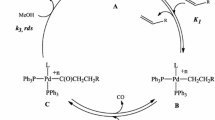Conclusions
-
1.
The catalytic reduction of terephthalyl dichloride over Pd/C to terephthalaldehyde is zero order with respect to substrate and first order with respect to hydrogen, and has low selectivity.
-
2.
The activity of supported catalysts in the reduction of the acid chloride group increases in the sequence Pt < Rh < Ru ≪ Pd. In aldehyde hydrogenation the sequence is Rh < Ru < Pt ≤ Pd.
-
3.
The reduction of terephthalyl dichloride proceeds by a stepwise mechanism. The selectivity is determined by the ratio of the hydrogenolysis rate of the C-Cl bonds of the acid chloride to the hydrogenation rate of the C(O)H group.
-
4.
Palladium supported on activated carbon in the presence of modifiers containing nitrogen or sulfur is the best catalyst for the reduction of terephthalyl dichloride to terephthalaldehyde.
Similar content being viewed by others
Literature cited
A. D. Delman, A. A. Stein, and B. B. Simms, J. Macromol. Sci.,Al, 147 (1967).
G. I. Kudryavtsev and T. I. Shtein, Khim. Volokna, No. 2, 5 (1978).
British Patent 953,909 (1964); Chem. Abstr.,61 118g (1964).
West German Patent No. 2,339,086, CO7c, 47/52 (1973); Ref. Zh. Khim., 18N22OP (1975).
West German Patent No. 2,556,206, CO7 47/52 (1975); Ref. Zh. Khim., 9N19OP (1978).
N. Froschl and A. Maier, Monatsh. Chem.,59, 256 (1932).
E. F. Litvin, L. Kh. Freidlin, G. K. Oparina, R. N. Gurskii, R. V. Istratova, and L. I. Gosteva, Zh. Org, Khim.,10, 1475 (1974).
E. F. Litvin, L. Kh. Freidlin, R. N. Gurskii, R. V. Istratova, and I. L. Vaisman, Izv. Akad. Nauk SSSR, Ser. Khim., 1736 (1975).
S. Affrossman and S. Thomson, J. Chem. Soc,37, 2024 (1962).
P. N. Rylander, Catalytic Hydrogenation Over Platinum Metals, Academic Press, New York-London (1967), p. 405.
E. F. Litvin, L. Kh. Freidlin, R. N. Gurskii, R. V. Istratova, and A. P. Presnov, Izv. Akad. Nauk SSSR, Ser. Khim., 2441 (1979).
J. Tsuje, K. Ohno, and T. Kajimoto, Tetrahedron Lett., 4565 (1965).
Author information
Authors and Affiliations
Additional information
Translated from Izvestiya Akademii Nauk SSSR, Seriya Khimicheskaya, No. 9, pp. 2093–2097, September, 1983.
Rights and permissions
About this article
Cite this article
Gurskii, R.N., Litvin, E.F., Istratova, R.V. et al. Selectivity of the catalytic reduction of terephthalyl dichloride to terephthalaldehyde. Russ Chem Bull 32, 1890–1894 (1983). https://doi.org/10.1007/BF00954666
Received:
Issue Date:
DOI: https://doi.org/10.1007/BF00954666




